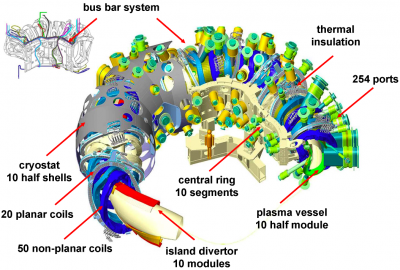W7-X: Difference between revisions
Jump to navigation
Jump to search
| Line 51: | Line 51: | ||
== References == | == References == | ||
* [[doi:10.1088/0741-3335/35/8/001|H. Wobig, ''The theoretical basis of a drift-optimized stellarator reactor'', Plasma Phys. Control. Fusion '''35''' (1993) 903]] | * [[doi:10.1088/0741-3335/35/8/001|H. Wobig, ''The theoretical basis of a drift-optimized stellarator reactor'', Plasma Phys. Control. Fusion '''35''' (1993) 903]] | ||
* J. Nührenberg et al., Trans. Fusion Technology '''27''' (1995) 71 | |||
* [[doi:10.1063/1.871924|C. Nührenberg, ''Global ideal magnetohydrodynamic stability analysis for the configurational space of Wendelstein 7–X'', Phys. Plasmas '''3''' (1996) 2401]] | * [[doi:10.1063/1.871924|C. Nührenberg, ''Global ideal magnetohydrodynamic stability analysis for the configurational space of Wendelstein 7–X'', Phys. Plasmas '''3''' (1996) 2401]] | ||
* [[doi:10.1109/FUSION.1997.685662|V. Erckmann et al, ''The W7-X project: scientific basis and technical realization'', Fusion Engineering '''6-10''' (1997) 40]] | * [[doi:10.1109/FUSION.1997.685662|V. Erckmann et al, ''The W7-X project: scientific basis and technical realization'', Fusion Engineering '''6-10''' (1997) 40]] | ||
Revision as of 12:31, 25 September 2011

Wendelstein 7-X (W7-X) is an experimental stellarator currently being built in Greifswald, Germany by the Max-Planck-Institut für Plasmaphysik (IPP). W7-X is an optimized stellarator, i.e. the magnetic field has been tailored to meet several physical optimization criteria.
| Parameter | Value | Unit |
|---|---|---|
| Major radius, R0: | 5.5 | m |
| Minor radius, a: | 0.53 | m |
| Plasma volume, V: | 30 | m3 |
| Non-planar coils: | 50 | |
| Planar coils: | 20 | |
| Number of ports: | 253 | |
| Rotational transform, ι/2π: | 5/6-5/4 | |
| Magnetic field on axis, B0: | <3 | T |
| Stored energy, W: | 600 | MJ |
| Heating power, P: | 15-30 | MW |
| Pulse length: | 30 | min |
| Machine height: | 4.5 | m |
| Machine diameter: | 16 | m |
| Machine mass: | 725 | t |
Optimization criteria
- Feasible modular coils
- Good, nested magnetic surfaces
- Good finite-β equilibria
- Good MHD stability
- Small neoclassical transport
- Small bootstrap current
- Good confinement of fast particles
See also
- Wendelstein 7-X (division)
- Wendelstein 7-X (project)
References
- H. Wobig, The theoretical basis of a drift-optimized stellarator reactor, Plasma Phys. Control. Fusion 35 (1993) 903
- J. Nührenberg et al., Trans. Fusion Technology 27 (1995) 71
- C. Nührenberg, Global ideal magnetohydrodynamic stability analysis for the configurational space of Wendelstein 7–X, Phys. Plasmas 3 (1996) 2401
- V. Erckmann et al, The W7-X project: scientific basis and technical realization, Fusion Engineering 6-10 (1997) 40
- M. Wanner and the W7-X Team, Design goals and status of the WENDELSTEIN 7-X project, Plasma Phys. Control. Fusion 42 (2000) 1179
- M. Wanner et al, Design and construction of WENDELSTEIN 7-X, Fusion Engineering and Design 56-57 (2001) 155-162
- M. Wanner et al, Status of WENDELSTEIN 7-X construction, Nucl. Fusion 43 (2003) 416
- M. Wanner and the W7-X Team, Construction and assembly of WENDELSTEIN 7-X, Fusion Engineering and Design 81, 20-22 (2006) 2305-2313
- L. Wegener, Status of Wendelstein 7-X construction, Fusion Engineering and Design 84, 2-6 (2009) 106-112
- H.-S. Bosch et al, Construction of Wendelstein 7-X; Engineering a Steady-State Stellarator, IEEE Trans. Plasma Science 38, 3 (2010) 265